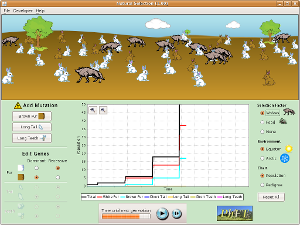Pre-Lab Questions – Answer them in your Eco-Log in
complete sentences. (don’t copy Qs)
1.
What
variables can you influence in this lab?
2.
Define
what a genetic mutation is. How do genetic mutations happen?
3.
What
selection factors might effect an animal population besides the ones used in
this lab?
4.
What
sorts of selection factors do you think affect real animal populations that are
endangered?
The
Experiments:
You will
observe what happens to the population of rabbits based on their
characteristics and factors in their habitat.
Fill in the
blanks in the following hypotheses to state your prediction of how the three
possible mutations will affect the population of rabbits under various
selective factor pressures and in different environments:
Hypothesis:
(fill in the blank here and copy your FIRST hypothesis into your EcoLog)
1.
In the
equatorial environment, (white or brown) ______________ rabbits will survive
best when wolves are introduced.
2.
In the
arctic environment, (white or brown) ______________ rabbits will survive best
when wolves are introduced.
3.
In the
equatorial environment, (long teeth or short teeth) ______________ rabbits will
survive best when food is the selective factor.
4.
In the
arctic environment, (long teeth or short teeth) ______________ rabbits will
survive best when food is the selective factor.
Now run the
simulation for each of your hypotheses (you will run the simulation 4 separate
times):
1.
After
you start the simulation “add a friend” and select your mutation (for
hypotheses 1 and 2 the mutation is “brown fur” for 3 and 4 it is “long teeth”)
2.
After
the 3rd generation pause the simulation and record data about the
population of rabbits… total, brown and white.
3.
Un-pause
the simulation and add your selective factor.
4.
Let
the simulation run for 4 more generations then pause it and record data about the
rabbit population again
Your data
table for each simulation should look something like this for Hypothesis #1 –
put it in your EcoLog under Hypothesis #1:
·
Write
your hypotheses and create data tables in your Eco-Log for hypotheses 2, 3 and
4.
·
Use
the population numbers from the simulation graph to get you numbers for the
tables, remember you can zoom in and out on the chart to get more accurate
reads.
Inquiry Bonus Question!
Inquiry Bonus Question!
- What do you think would happen if you ran one of your simulations in equatorial conditions again but after the 6th generation you switch the environment from equatorial to arctic? Write a hypothesis about this and create a data table which measures the rabbit population at the 3rd, 7th and 10th generations.
Post-Lab Questions - Answer in your EcoLog in full sentences
1.
Based
upon your evidence from the simulation what conclusion are you able to make
about what happens to animals that cannot compete as well with other animals in
the wild?
2.
Why
does the make-up of the population change over time when selective factors are
introduced?
3.
If
only one species is considered the "fittest", why do we still have so
many variations among species. Why do some birds have very long pointy beaks,
while other birds have short flat beaks?
4.
How do
you think diseases can affect natural selection?
5.
Describe
three ways you think humans might act as a selective factor for an animal or plant
species.




